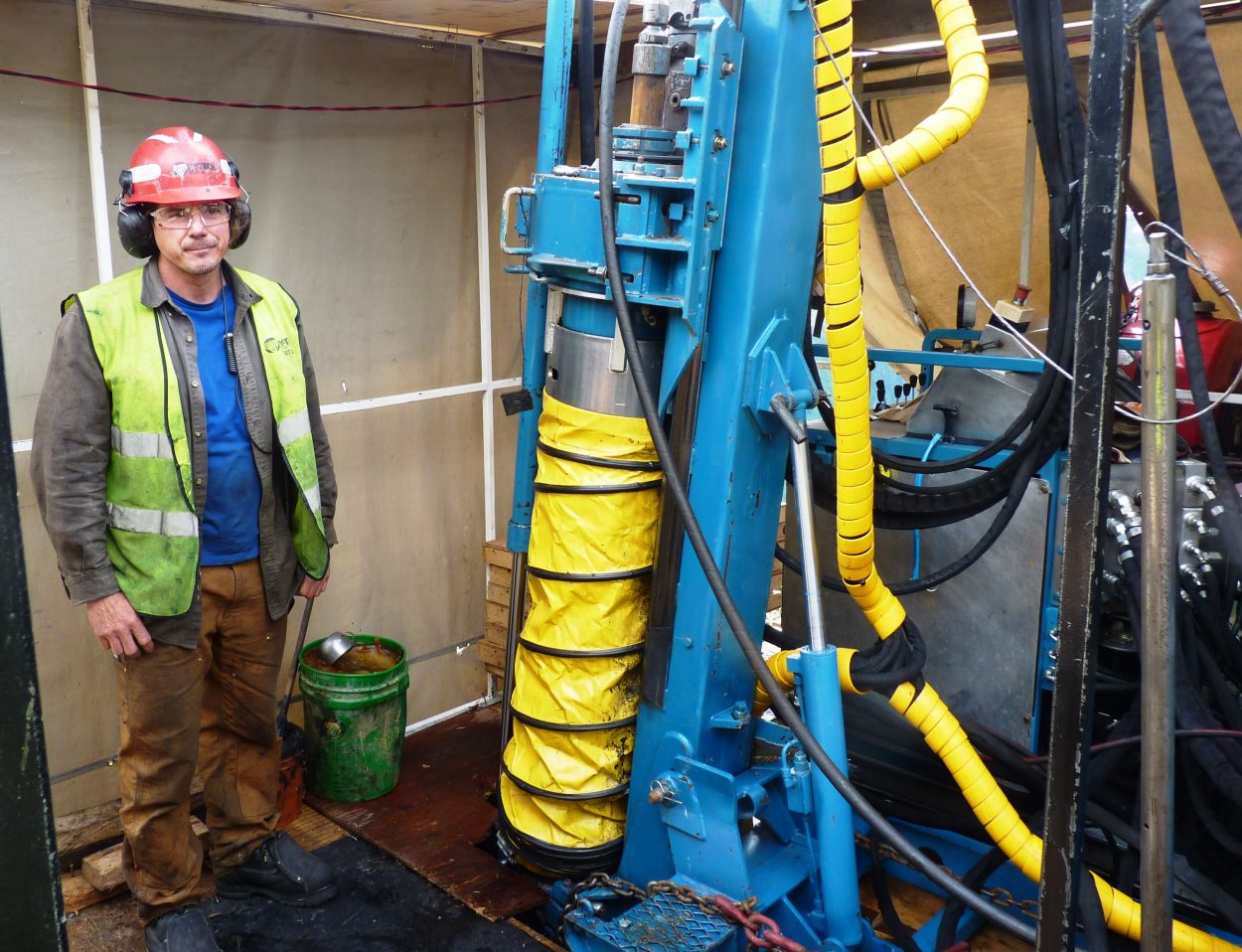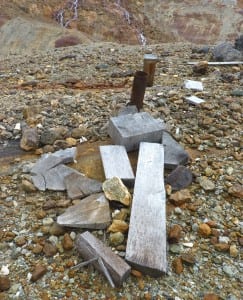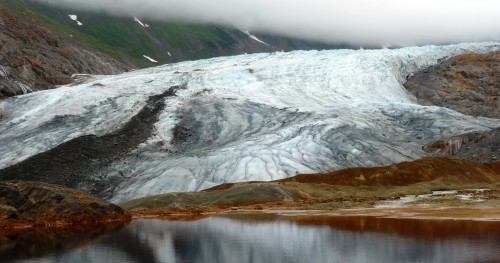
A glacier reflects in a naturally occurring pool of rusty, acidic water at the site of one of the KSM Prospect’s planned open-pit mines. The British Columbia project, northeast of Ketchikan and east of Wrangell, just finished the year’s exploration program. (Ed Schoenfeld/CoastAlaska News)
British Columbia’s Kerr-Sulphurets-Mitchell mining project wrapped up its 2015 exploration season in late September. The KSM, about 30 miles east of the Alaska border, is the largest of 10 or so such projects near waterways that flow into Southeast.
Its owner, Toronto-based Seabridge Gold, has already spent close to $200 million, in U.S. dollars, searching for ore. Here, we take you there to learn about the exploration process.
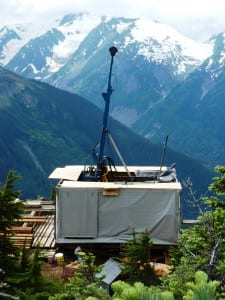
A KSM drill rig perches above a deep valley about 80 miles east of Wrangell. (Ed Schoenfeld/CoastAlaska News)
A drill rig grinds into the bedrock of a high ridge, overlooking a wilderness of snow-capped mountains and lushly vegetated valleys. The bright blue rig juts up through the roof of a rough shack of sturdy tarps, sheets of plywood and heavy timber.
Inside, Jeff Skinner is setting up the diesel-powered, hydraulic drill rig for its next run.
“Well, we’re doing mineral exploration for these gentlemen. We’re drilling the hole, pulling the rock samples out of the ground and sending them down to the geologists and they take care of it from there,” he says.
Long, brownish pipes are lined up outside the shack, waiting to be used.
“They put the steel in a giant drill chuck, like you’d have in a hand drill. And turn it at high speed with a diamond bit at the end,” says Bill Threlkeld, senior vice president for exploration for Seabridge Gold, which has drilled 383 holes at the KSM over the past 10 years.
The pipes are sent deep into the ground and an inner sleeve brings back cylindrical samples, called cores. Threlkeld says they help pinpoint the location of the richest gold and copper deposits.
“It was at roughly 700 meters depth, so 2,100 feet, more or less, down.Before the work on this hole is done, the drill will reach more than two-thirds of a mile into the Earth,” he says.
Down below, on a rise in the valley floor, an open, rusty pipe juts out of a small pile of rocks and timber. Brent Murphy, Seabridge’s vice president for environmental affairs, reads its label.
“We have Mitchell 0-6, so it’s Mitchell, drilled in 2006, zero-one, first hole,” he says.
He’s taken me to near the end of a valley that can only be described as “raw.” It’s bare rock, with no trees or bushes.
At the valley’s upper end is what’s left of the glacier that once filled this U-shaped valley. Murphy says “once” wasn’t that long ago.
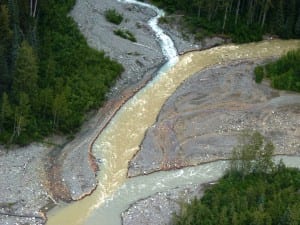
Sulphurets Creek, which drains naturally occurring rusty water from the KSM prospect, enters the Unuk River, which drains into the ocean northeast of Ketchikan.. (Ed Schoenfeld/CoastAlaska News)
“We’re walking to an area where six years ago, where we’re standing, the ice would have been 10 feet above our outstretched arms. So you can see how much it’s receded,” he says.
The valley is splotched and streaked with rust, reddish-brown streams flowing down its sides.
The color comes from exposed iron, which reacts with air and water.
“This is oxidation. Natural oxidation. And this is what produces the acid, which everyone has concerns about for water contamination,” he says.
Acidic water from mines and stored waste rock can hurt or kill fish, including those Alaskans depend on for food and jobs. KSM developers say it will be treated and stored properly at the site, about 80 miles east of Wrangell. Critics in Southeast cast strong doubts.
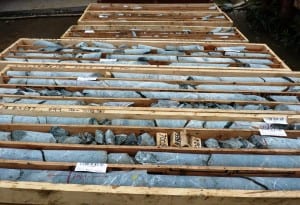
Rock cores wait for analysis at the Kerr-Sulphurets-Mitchell project, one of the British Columbia mines planned for near the Southeast Alaska border. (Ed Schoenfeld, CoastAlaska News)
Up one side of the valley is a much different color. It looks like someone spilled a very large can of paint while ascending the ridge.
The blueish-green is just an indication that there’s copper in the system here. It gets exposed to the atmosphere and the copper comes out of solution. It’s an indication we’re in a mineral-rich area.
Because in this part of the world, where you find copper, you find gold.
After the cores are drilled out of the bedrock, they’re flown by helicopter to the KSM’s analysis operation, farther down the valley.
They’re cut into clearly labeled pieces for examination.
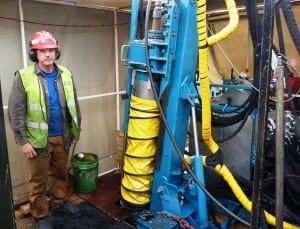
A drilling-crew member poses during a break at Seabridge Gold’s KSM Mine. (Ed Schoenfeld/CoastAlaska News)
Inside another wood-and-tarp building, Michelle Campbell points to the computer screen of what’s called a hyperspectral imaging device.
“A regular camera just looks at three spectral bands. But this one looks at 214 different spectral bands, so it’s much more precise,” she says.
The picture is electronically enhanced to show what’s on the surface of the rock core. She’s happy with what she sees, the presence of valuable metals.
“So in this one it would be like the reds and some of these darker, like brownie, colors. [They’re] the good stuff,” she says.
The cores, and the enhanced images, undergo further scrutiny before being shipped south for more detailed analysis by an independent lab. Those results determine whether and where the company will mine.
But other factors come into play. Seabridge Gold has the main provincial and federal permits needed to turn its exploration project into a mine. But it’ll still need to raise more than $5 billion, U.S., from potential investors.

